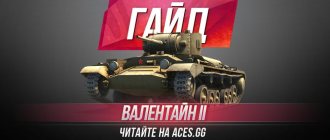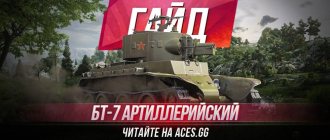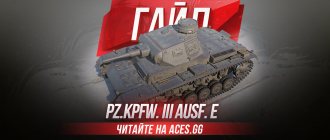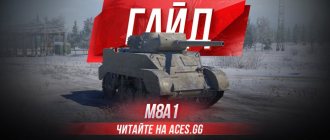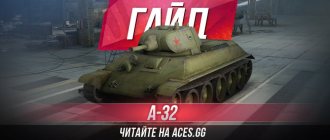Hello to all fans of sandbox racing, aces.gg is here! As you may have guessed, now we will talk about one of the representatives of low-level technology. We will talk about the Swedish light tank of the second level and in front of you Strv m/38 guide
.
Of course, the second level in each development branch, if you focus on fast leveling, is intermediate. However, for completeness, we will look at the Strv m/38 characteristics
and compare this tank with its classmates.
TTX Strv m/38
In terms of generalized parameters, our little Swede has a safety margin that is standard by LT-2 standards, as well as a good, but not the longest, base viewing range of 300 meters.
If we consider the Strv m/38 performance characteristics
reservations, everything is very mediocre, our armor is absolutely cardboard. This means that this tank will be able to penetrate without any problems even from machine guns. As you understand, there is no point in looking separately at the front of the car or the sides; there are equally few millimeters all around, so in battle you should be especially attentive and careful.
In terms of mobility, it’s a stretch to call our tank light, since Strv m/38 World of Tanks
has a rather weak top speed, but more importantly, we have mediocre dynamics, due to an insufficient ratio of horsepower to a ton of weight.
But maneuverability is all right; the Swedish Strv m/38 tank
quite briskly.
gun
And now, according to tradition, the time has come to draw your attention to the armament of this unit and I would immediately like to say that the gun at our disposal is average.
So, Strv m/38 gun
has the same alphastrike as most light tanks of its classmates, approximately the same rate of fire as most, and therefore, we deal the standard 1065 units of damage per minute, which is not a lot.
As for the parameters of armor penetration, our gun is quite good in this regard, Strv m/38 WoT
can feel comfortable at the top of the list, but there will be problems with some third levels; for a comfortable game, it is still better to carry some gold with you.
If we talk about the accuracy of the gun, like most tanks at the level, the light tank Strv m/38 World of Tanks
has a large spread and poor stabilization, so it is very difficult to deal damage while moving. True, these shortcomings are more than compensated for by fast aiming, and on our side there are simply excellent vertical aiming angles, because the barrel goes down 15 degrees.
Design description[edit]
Hull and armor[edit]
The hull of the light tank had a riveted-welded design. It was assembled from sheets of rolled armor steel of different thicknesses. Thus, the frontal plates of the tank hull were 15 mm thick; they were located at significant angles of inclination, which increased the thickness of the armor. The sides of the hull were also made of armor plates 15 mm thick, but the roof and bottom of the hull were only 6 mm thick.
The layout of the tank hull was classic. In the front part there was a control compartment and transmission. The driver's position was located on the left side of the tank and was distinguished by a small cabin with a rectangular hatch and three viewing devices with triplexes. The fighting compartment occupied the middle part of the hull. Here were the seats of the tank commander and gunner. A conical turret was installed on the roof of the fighting compartment. In the front armored mantlet, strongly pushed forward, there was a cannon and a coaxial machine gun. The aft niche of the tower was intended to install a radio station. The whip-type antenna was placed on the left side of the tower. Also on the roof of the tower, offset to the right side, was located the commander's cupola, and on the left in front there was a periscope sight in an armored cap. To evacuate the crew, armored hatches were placed on both sides of the turret.
Weapons[edit]
The weapon of choice was a 37 mm anti-tank gun. In Sweden, the gun was adopted for service in 1937 under the designation 37-mm infanterikanon m/34 (model 1934 - infantry gun). In 1938, the gun was slightly modernized and produced as the 37-mm pansarvarnskanon m/38 (model 1938 - anti-tank gun). There was also a tank version of the gun called 37 mm Kanon m/38 stridsvagn. The 37-mm Bofors cannon had high combat qualities for its time and was capable of hitting almost any tank. At a distance of up to 300 meters, an armor-piercing projectile could penetrate armor up to 60 mm thick, up to 500 meters - 48 mm, up to 1000 meters - 30 mm, up to 2000 meters - 20 mm. The armor-piercing projectile weighed 700 grams and developed an initial speed of 810 m/s. The practical range was 7100 meters, the rate of fire was 10 rounds per minute.
| Armor penetration table for the 37 mm Bofors anti-tank gun | |
| Armor-piercing tracer chamber projectile Marskin panssarintuhoojat | |
| Range, m | At a meeting angle of 60°, mm |
| 300 | 42 |
| 500 | 37 |
| 1000 | 28 |
| Information is provided from Finnish sources; the methodology for measuring penetration power is unknown. It should be remembered that armor penetration indicators can vary noticeably when using different batches of shells and different armor manufacturing technologies. | |
In addition to the cannon, the tank was also armed with an 8-mm Karlskrona Ksp m/36 machine gun. The machine gun was a licensed copy of the aviation version of the Browning m/22 (Ksp m/22) chambered for the new 8-mm cartridge 8×63 m/32 (real caliber 7.87 mm). The new cartridge with a 14.2-gram bullet, which had an initial speed of 760 m/s, was almost twice as powerful in terms of muzzle energy as the old 6.5x55 cartridge and 25% greater than the American Springfield .30-06 cartridge. The machine gun's spring buffer assembly was redesigned, the extractor assembly was redesigned, and the trigger mechanism was changed. The production of these machine guns in Sweden and the weapons department continued until the end of 1944[1].
Engine and transmission[edit]
At the rear of the hull there was a 6-cylinder Scania-Vabis 1664 gasoline engine that developed 142 hp. The fuel tank was also located here, as well as the cooling and lubrication systems. Special hatches were made in the roof of the engine compartment and in the rear armor plate for access to the power plant. The tank's transmission included a dry friction main clutch, a 5-speed manual gearbox, side clutches and a locking differential.
Chassis[edit]
The chassis of the new tank included 4 double rollers with a rubber band and an individual torsion bar suspension, as well as two support rollers (for each side), a rear idler wheel (sloth) and a toothed front drive wheel. To reduce the specific load and improve traction while moving, the sloth almost lay on the ground.
Advantages and disadvantages
In order to properly develop your tank, that is, equip it with the necessary equipment, learn the necessary perks and go into battle, you need to know some nuances. Of course, we are talking about what Strv m/38 WoT
there are strengths and weaknesses, now let’s unwind. Pros: • Good damage per minute; • Fast convergence speed; • Very comfortable vertical aiming angles; • Small dimensions. Cons: • Weak armor; • Mediocre mobility; • Poor accuracy; • Small margin of safety and visibility.
Equipment for Strv m/38
Now that you know the advantages and disadvantages of the machine, you can think about how to outfit it. Of course, at the second level with a variety of additional modules the situation is tense, so for Strv m/38 equipment
Let's put the following: 1. – the best option of all available, because we get a 5% improvement in several very important characteristics. 2. – will slightly boost weak basic vision, and in combination with the first point there is a chance to gain an advantage over enemy classmates. 3. – we don’t have a better alternative, so why not improve the comfort of dealing damage by speeding up the aiming?
Analysis of the characteristics of Strv m 42 - 57 Alt A.2
Having already looked at the final characteristics after the Wot SuperTest, you can see that the visibility of the tank has been reduced by 10 meters, which is now 350 meters and is the lowest at the level. They also reduced penetration by gold shells by 20 units, which is 190 , not to say that much, but the lower armor plate of the Soviet heavy tank IS 3 will be penetrated every other time. The drum reload time is less than 17 seconds , and between shells is 2 seconds , which shows a very good result. But the aiming speed of the gun let us down, which is 2.3 seconds and does not allow the drum to be deployed along the CD, and after a shot you have to constantly adjust it.
Tactics for playing on Strv m/38
You all understand perfectly well that in the sandbox it is difficult to adhere to any specific strategy; chaos and confusion always reign here. However, certain nuances should still be taken into account on the Strv m/38 tactics
combat must involve maximum caution.
In order not to merge at the very beginning of the battle, you should not fly ahead of the entire planet, let the most desperate ones pass, and let the enemy be distracted by them. You, in turn, can start exterminating the same heads from the enemy team, from Strv m/38 WoT
there is everything necessary for this.
Also, regardless of the map you find yourself on and your position in the list, try to use the terrain, various ruins, embankments and even downed tanks to your advantage. Strv m/38 tank of Sweden
has excellent vertical aiming angles, and showing the enemy only your small tower, provided that you do not stand still all the time, can be exchanged for a noticeable plus in HP.
You can also stick to the second line; due to the lack of armor and mediocre mobility, such passive tactics pay off. In addition, the light tank Strv m/38 World of Tanks
It has a good gun and you shouldn’t have any problems dealing damage at long ranges.
To summarize, I would like to remind you that you cannot face more than one enemy at a time, constantly monitor the mini-map and remember, Strv m/38 Swedish tank
very good for its level and you can show good results if you play carefully.
High quality and very expensive
The Swedish military had to wait quite a long time for a decent result from the domestic tank industry. Work on tanks of our own design began in Sweden back in the late 20s, but we had to wait almost 10 years for tangible and satisfactory results.
However, due to the fact that the Germans, in a certain sense, used Swedish industry as a testing ground for their own experiments, by the second half of the 30s the Swedes had rich experience in tank building.
the Landsverk L-60 light tank, developed under the leadership of German designer Otto Merker, became the first tracked combat vehicle that Sweden exported. The design of the same tank formed the basis for two similar vehicles, Strv m/38 and Strv m/39, adopted by the Swedish army.
First serial
The Swedes themselves were in no hurry to adopt the L-60 tank. Their caution was understandable: the L-10 (Strv m/31) and L-30 (Strv fm/31) tanks developed by Merker in the early 30s turned out to be quite interesting, but not without shortcomings, and their price was not at all pleasing . Only after the first of the L-60s went to Ireland did the Swedish military finally pay close attention to the domestic tank. The order for its Swedish modification, designated Landsverk L-60S, was placed in July 1936.
The tank, designed by Otto Merker, had outstanding characteristics for its time and had a number of original ideas in its design, including the first torsion bar suspension used on a tank. However, the Swedish military has made a number of claims to this vehicle.
Firstly, they were not at all happy with the fact that the Swedish tank had a German engine. If relations between the countries cooled (and the Swedes saw very well what was happening in Europe), the tanks could be left without engines. And the Büssing-NAG L8V-G engine was by no means indispensable. Sweden also had its own production of engines with similar parameters. We are talking about engines for Scania-Vabis 335 trucks, which have been produced since 1931. In 1936, these cars received an in-line 6-cylinder Scania-Vabis 1664 engine with a volume of 7.75 liters and a power of 140 horsepower. It was slightly larger than the Büssing-NAG L8V-G, but had very similar characteristics. It was this engine that was decided to be installed on the Landsverk L-60S.
Turret Landsverk L-60S, drawing S-21116 dated March 6, 1937. This is exactly the turret that was installed on tank No. 62
There were also complaints about the tower. The fact is that the L-60, developed for Ireland, did not have a radio station. Since there was no place in the body to place the radio, the only place left was the tower. But here, too, there was simply no free space for a very important element of equipment for a modern tank. Creating a rear niche in the turret to accommodate the radio was an obvious way to solve this problem.
The Swedish military was not satisfied with the L-60's armament either. In their opinion, instead of the Danish 20 mm Madsen cannon, the tank should have been armed with a tank version of the 37 mm Bofors anti-tank gun. Not only was this gun much more powerful, but it was also produced in Sweden itself, which removed the risk of a sudden cessation of supplies of guns from Denmark.
Project for installing automatic guns of 20 and 37 mm caliber in the Landsverk L-60S turret, drawing S-1042 dated April 19, 1937
Work on installing a radio in the L-60 turret began at the beginning of 1936. Then the turret received a rear niche similar to the one the Poles made on their 7TP tank. However, the Swedes quickly abandoned this half-measure.
The final appearance of the Landsverk L-60S began to take shape by the spring of 1937. At the same time, the tank that is today known under the designation Strv m/38 did not appear immediately. At first, Landsverk engineers saw the new tank as somewhat different, and this was especially true for the turret. Tank No. 62, the first Landsverk L-60S built, was equipped with a 1937 design turret and did not look like a production product at all.
Landsverk L-60S No. 62, summer 1937. It is clearly noticeable that the frontal part of the hull and the nose of the turret differ from the serial Strv m/38
In accordance with the requirements received from the military, the tower received a developed aft niche. It housed a radio station, the antenna port of which was located on the left side. In addition, the loader (who is also the tank commander) received a commander's cupola. The frontal part of the turret has also undergone modifications. The armament did not change compared to its predecessor tank: despite the requirements of the Swedish military, the 20-mm Madsen automatic cannon was still used. True, it was shifted greatly to the right, and the designers abandoned the uniform armor of the gun mantlet.
Experimental tank No. 62, side view
Why this was done can be easily understood from drawing S-1042 dated April 19, 1937. Landsverk engineers tried to make the turret universal, that is, to allow the installation of different guns in it. The 37-mm Bofors m/38 cannon, by the way, was not even included in this list at first. Among the weapons whose installation was being studied were 20-mm Madsen and Solothurn automatic cannons, as well as a 37-mm Bofors automatic cannon.
However, it quickly became clear that the idea with an automatic cannon was unsuccessful. The fact is that the tank's turret turned out to be too narrow in the frontal part. As a result, there was still room for either a coaxial machine gun or a magazine for an automatic cannon.
Final configuration of the Landsverk L-60S accepted for mass production
In the end, tank No. 62 was built by July 1937 with a turret created according to drawings from March. The armament remained in the form of a 20 mm Madsen automatic cannon and a ksp 8 mm m/36 strv coaxial machine gun. The hull of the vehicle also had certain differences from tank No. 61: the nose was made like its lighter brother, the Landsverk L-120. But based on the test results, this design of the front hull sheet was abandoned because its strength had decreased. However, the first version of the frontal part of the hull had one vulnerable detail, which the designers never abandoned. Directly in the center of the upper frontal sheet there was a headlight, covered with an armored casing.
The turret of tank No. 62 also did not go into production. The new type of gun mantlet looked extremely unreliable, and the coaxial machine gun with the ability to aim horizontally separately from the gun did not provide any particular benefits.
Strv m/38 No. 77 in the Landsverk yard, March 1939. To install the antenna on the move, the tank had a special bracket
On September 10, 1937, the Swedish military decided to purchase fifteen L60-S tanks, which received the army designation Strv m/38. The sixteenth vehicle in the series was experimental chassis No. 61, which was brought to the status of a full-fledged tank in 1938. As for tank No. 62, it was later used for various experiments, including conversion into a self-propelled gun.
Tank No. 61, converted into the first production Strv m/38, received a turret that had a gun mount similar to the Landsverk L-60, only instead of a 20-mm automatic cannon, a 37-mm Bofors m/38 cannon was finally installed in it. The frontal part of the hull looked similar to the Landsverk L-60, from which, however, the access hatch to the main gear was removed.
The same tank from the front
Serial production of the Strv m/38 began at Landsverk on August 25, 1938, and the last tank, serial number 77, was produced in March 1939. The pace of production, to put it mildly, was not amazing, which ultimately forced the Swedish military to look for an alternative for the domestic tank abroad.
But Landsverk can hardly be blamed for slowing down production. Despite the fact that Sweden had a developed industry, its potential should not be overestimated. The Swedes did not plan to fight, and the batch of 15 tanks for Landsverk was quite large: in all previous years, this enterprise had produced fewer tracked combat vehicles. In addition, the financial issue was also very acute.
Strv m/38 No. 77 rear
In 1939, tanks began to arrive in combat units of the Swedish army. The first eight Strv m/38s entered the Gotaland Life Guards Infantry Regiment (Göta livgarde, I 2), stationed in Stockholm. In the fall of 1939, his equipment transferred to other formations. The first of these was the Skaraborg Infantry Regiment (Skaraborgs regemente, I 9) in Skövde. In 1942, this infantry regiment, which had existed since 1624, was reorganized into the Skaraborg Tank Regiment (Skaraborgs pansarregemente, P 4).
The remaining tanks went to the Södermanlands Infantry Regiment (Södermanlands regemente, I 10), which was stationed in Strängnäs. This part also had a rich history and traced its lineage back to 1634. In 1942, Regiment I 9 was also reorganized into a tank regiment (P 3). By the way, the current storerooms of the Swedish tank museum Arsenalen are located on the site where this regiment was previously stationed. In 1963, after reorganization, it received the P 10 index, and in 2005 it ceased to exist. By the way, Stefan Karlsson, head of the Arsenalen Museum, served in the P 10 tank regiment.
Strv m/38 during Swedish army exercises
The service of the Strv m/38 turned out to be quite long. Tanks with serial numbers 63, 64, 66, 67, 68, 70, 71, 74, 75 and 76 were eventually transferred to the Skånska kavalleriregementet, K 2, stationed in Helsingborg. Of these cars, two have survived to this day - No. 63, now located in the Hasleholm Museum, and No. 66, exhibited at the Arsenalen Museum. Tank No. 63 is interesting because its controls have been redesigned: instead of the standard steering wheel, the driver has levers at his disposal. In addition, during operation, the body kit of this vehicle changed somewhat, in particular, mounts for spare tracks appeared at the rear.
The Strv m/38 were finally decommissioned only in 1957.
Modernization according to the German model
Despite the fact that the turret of tank No. 62 never went into production, it did not go unnoticed by Swedish tank building. Landsverk engineers returned to the idea with the main armament shifted to the side in 1939. To a large extent, they were led to this decision by the appearance of information on the German medium tank ZW, also known as Pz.Kpfw.III. The fact is that the German tank had not one, but two coaxial machine guns, and it was possible to aim them vertically separately from the gun.
Using the turret of tank No. 62 as a basis, Landsverk engineers developed a new design. This time the cannon was moved to the left, and two coaxial machine guns were placed on the right. In order for the machine guns to fit into the front plate of the turret, this part had to be expanded. The designers again abandoned the idea of a single mask reservation. The armor of the 37-mm Bofors tank gun reliably covered the installation. As for the twin machine guns, they were installed in ball mounts, covered at the front with separate armor. Thanks to ball mounts, coaxial machine guns could be aimed at a target separately from the gun, not only in the vertical, but also in the horizontal plane.
Drawing of a redesigned Landsverk L-60S turret with twin machine guns
Meanwhile, things were getting hotter in Europe. In March 1939, Czechoslovakia was occupied and divided, and on September 1, Germany attacked Poland. It was obvious that only a large and combat-ready army would help ensure Sweden's neutrality.
Tanks in this regard were an effective, but very expensive means of reinforcement. The Swedish treasury was unable to allocate large amounts of funding at a time. The government needed a very compelling reason to allocate substantial sums for a small kingdom. In October 1939, the commander of the Swedish army, Per Sylvan, approached King Gustav V with a request for 18 million Swedish kronor to purchase 104 tanks. As a result, on November 28, parliament approved the allocation of only 4 million crowns for the purchase of 20 tanks. And after just 2 days, the war began between the USSR and Finland.
By the way, the allocated budget speaks very eloquently about the price of Landsverk products. The Swedish krona at that time was more expensive than the French franc, and 200,000 kroner for one tank was a very considerable amount. In terms of price, the Landsverk L-60 was comparable to the Pz.Kpfw.III, although in terms of combat capabilities it was more comparable to the BT-7, which cost more than 2 times less. Even closer to the Swedish tank in terms of tactical and technical characteristics was the Czechoslovak LT.vz.38, which even in its most expensive version was also 2 times cheaper. It is not at all surprising that the Swedish military conducted very active negotiations with the Czech company ČKD, which ultimately led to the appearance of the Strv m/41.
Strv m/39 with serial number 85 in the factory yard, 1940
On December 19, 1939, the Swedish military signed another contract with Landsverk for the production of 20 Landsverk L-60S/II tanks. In the army, this vehicle was designated Strv m/39. The second series turned out to be more than just a reprint of the Strv m/38. In addition to the redesigned turret, these tanks had enough changes to both the hull and internal components.
The designers abandoned control using the steering wheel; instead, the driver received conventional levers. The large hatch for access to the main gear returned to its place, and in addition to it, another hatch appeared on the lower frontal sheet, somewhat reminiscent of a bowl.
The design of the frontal part of the hull has changed: instead of butt welding, the bottom sheet is now made with a bend. In this case, the upper frontal sheet was bolted and could be completely removed. This decision was very strange and clearly did not contribute to increasing projectile resistance. The shape of the over-engine plate, which received a massive stamping, has also become somewhat more complicated. The modifications led to an increase in the tank's combat weight to 8.7 tons.
Strv m/39 from tank regiment P 3, Strängnäs, 1943. It is clearly noticeable how the frontal part of the hull has changed
It was assumed that deliveries of two dozen Strv m/39 would end in October 1940. In fact, Landsverk was able to complete tank production only in the spring of 1941. The reason was a disruption in the supply of 37-mm guns from Bofors. The tanks received serial numbers 80–99. The vehicles were distributed between the infantry regiments I 9 (future tank regiment P4) and I 10 (P 3). Later, tanks with serial numbers 90, 91, 92 and 94 were transferred to the K2 cavalry regiment.
A number of changes were made to the shape of the engine compartment
Unlike the Strv m/38, which avoided truly serious modernization, the Strv m/39 underwent serious alterations during the war. The Swedes closely monitored the progress of military operations and drew certain conclusions from them. In particular, it was clear that the 15 mm thick armor in the front part did not meet modern requirements.
As a result, a program to strengthen the armor appeared, which was implemented on the Strv m/39 together with later tanks - the Strv m/40 (L-60S/III). Bonks were welded onto the upper frontal sheet of the hull, to which screens 35 mm thick were bolted. The upper part of the hull received additional armor; screens also covered the driver's cabin. The turret armor also received reinforcement, and here the screens were welded. The gun's armor was replaced with thicker armor. The weight of the Strv m/39 with enhanced armor protection increased to 9.36 tons.
Thanks to their successful design, tanks of the 1st and 2nd series served in the Swedish army until 1957
The Strv m/39 served for about the same amount of time as their predecessors. Despite the fact that Swedish light tanks were expensive, they also had significant advantages. First of all, this concerned reliability. In addition, from the point of view of ease of use and organization of internal space, the L-60S turned out to be at a high level. Even a tall tanker could easily fit inside such a combat vehicle, and the internal equipment was conveniently located. Combined with the frugality of the Swedes, it is not surprising that the last such machines were written off only in 1957.
Two Strv m/39 have survived to this day. The first of them, with serial number 90, is now in the Beredskapsmuseet museum near Helsingborg. The second tank with serial number 94 is in the storage rooms of the Arsenalen Museum. Both of these vehicles have been modernized, but the shielding from the upper frontal plate has been removed.
The author expresses great gratitude to Karl Blomster ,
Sweden , for his assistance in preparing the material and providing illustrations.
Sources and literature:
- RGVA
- Karl Blomster Archive
- https://tanks.mod16.org
- Landsverk L-60, Christer Baadstе, PANSAR 1–2013, 2–2013


